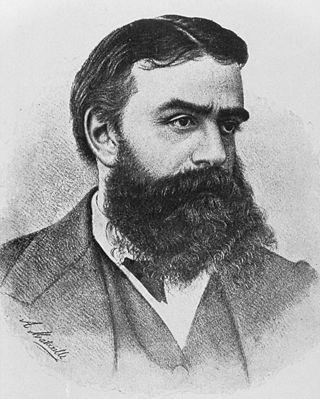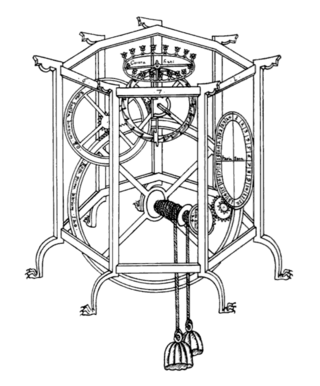
Giuseppe Piazzi was an Italian Catholic priest of the Theatine order, mathematician, and astronomer. He established an observatory at Palermo, now the Osservatorio Astronomico di Palermo – Giuseppe S. Vaiana. He is perhaps most famous for his discovery of the first dwarf planet, Ceres.

Johann Franz Encke was a German astronomer. Among his activities, he worked on the calculation of the periods of comets and asteroids, measured the distance from the Earth to the Sun, and made observations of the planet Saturn.

Giovanni Alfonso Borelli was a Renaissance Italian physiologist, physicist, and mathematician who is often described as the father of biomechanics. He contributed to the modern principle of scientific investigation by continuing Galileo's practice of testing hypotheses against observation. Trained in mathematics, Borelli also made extensive studies of Jupiter's moons, the mechanics of animal locomotion and, in microscopy, of the constituents of blood. He also used microscopy to investigate the stomatal movement of plants, and undertook studies in medicine and geology. During his career, he enjoyed the patronage of Queen Christina of Sweden. He was the first scientist to explain that animal and human bodily movements are caused by muscular contractions.

Pierre François André Méchain was a French astronomer and surveyor who, with Charles Messier, was a major contributor to the early study of deep-sky objects and comets.

Geminiano Montanari was an Italian astronomer, lens-maker, and proponent of the experimental approach to science. He was a member of various learned academies, notably the Accademia dei Gelati. Montanari's famous students include Domenico Guglielmini, Francesco Bianchini, Gianantonio Davia and Luigi Ferdinando Marsili.
William Henry Finlay (FRAS) was a South African astronomer. He was First Assistant at the Cape Observatory from 1873 to 1898 under Edward James Stone. He discovered the periodic comet 15P/Finlay. Earlier, he was one of the first to spot the "Great Comet of 1882". The first telegraphic determinations of longitude along the western coast of Africa were made by Finlay and T. F. Pullen.

Giovanni Battista Donati was an Italian astronomer.

Benedetto Castelli, born Antonio Castelli, was an Italian mathematician. Benedetto was his name in religion on entering the Benedictine Order in 1595.

The Brera Observatory is an astronomical observatory in the Brera district of Milan, Italy. It was built in the historic Palazzo Brera in 1764 by the Jesuit astronomer Roger Boscovich. Following the suppression of the Jesuits by Clement XIV on 21 July 1773, the palace and the observatory passed to the then rulers of northern Italy, the Austrian Habsburg dynasty.

Giovanni Dondi dall'Orologio, also known as Giovanni de' Dondi, was an Italian physician, astronomer and mechanical engineer in Padua, now in Italy.

The Maragheh observatory, also spelled Maragha, Maragah, Marageh, and Maraga, was an astronomical observatory established in the mid 13th century under the patronage of the Ilkhanid Hulagu and the directorship of Nasir al-Din al-Tusi, a Persian scientist and astronomer. The observatory is located on the west side of Maragheh, which is situated in today's East Azerbaijan Province of Iran. It was considered one of the most advanced scientific institutions in Eurasia because it was a center for many groundbreaking calculations in mathematics and astronomy. It housed a large collection of astronomical instruments and books and it served as an educational institution. It was also used as a model for the later Ulugh Beg Observatory in Samarkand, the Taqi al-Din observatory in Constantinople, and Jantar Mantar observatory in Jaipur.

Andrea Argoli, born in Tagliacozzo, was an Italian mathematician, astronomer and astrologer. He was one of the most important 17th-century makers of ephemerides, which gave the positions of astronomical objects in the sky at a given time or times.
Santini is an Italian surname. Notable people with the surname include:

Andrea Milani Comparetti was an Italian mathematician and astronomer, based at the University of Pisa.
Virgilio Trettenero was an Italian mathematician and astronomer born in Recoaro Terme, Province of Vicenza, Italy. Active between 1848–1863, his name is linked to the creation of the stellar catalogs, a work initiated by Giovanni Padovani in 1838 using the meridian circle, which he purchased. The asteroid 16715 Trettenero, discovered on 20 October 1995 at the San Vittore Observatory, in Bologna, was named so in his honour.

Comets have been observed by humanity for thousands of years, but only in the past few centuries have they been studied as astronomical phenomena. Before modern times, great comets caused worldwide fear, considered bad omens foreboding disaster and turmoil, for example the 1066 passage of Halley's Comet depicted as heralding the Norman conquest of England. As the science of astronomy developed planetary theories, understanding the nature and composition of comets became a challenging mystery and a large area of study.
Giovanni Camillo Glorioso was an Italian mathematician and astronomer. He was a friend of Marino Ghetaldi and Galileo Galilei's successor as professor of mathematics at Padua.

Giuseppe Lorenzoni was an Italian astronomer who identified helium on the sun using spectroscopy, independently of others like Charles Augustus Young. He served as a director of the Padua Observatory from 1878 until his death and served as a professor of astronomy at the University of Padua from 1872.

Georgios Konstantinos Vouris (Greek: Γεώργιος Κωνσταντίνου Βούρης; aka Georg Konstantin Bouris was a Greek astronomer, physicist, mathematician, author, and professor. He was a pioneer in 19th-century Greek astronomy. Vouris lobbied tirelessly to create an astronomical observatory in Athens. He was the first director of the National Observatory of Athens. It was completed in 1846. Greece reconnected with its Astronomical roots. It was the first time since antiquity that a country named Greece played a significant role in Astronomy. He was the first author to publish a university textbook in the field of mathematics since the inception of the new country.















